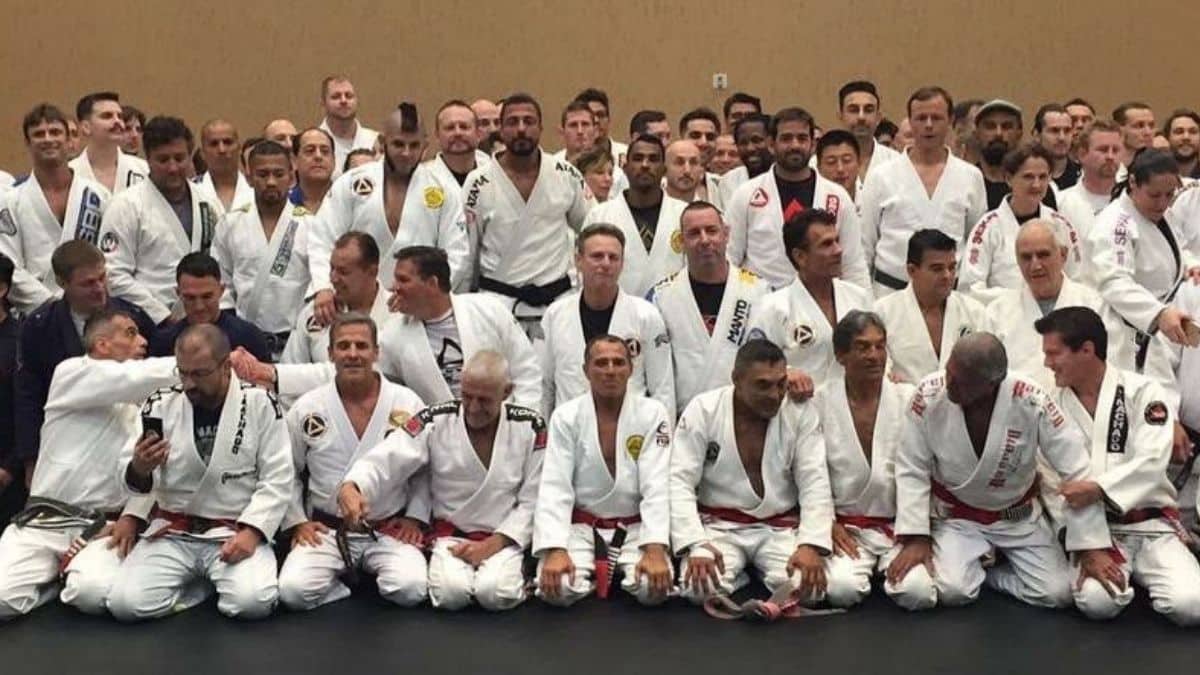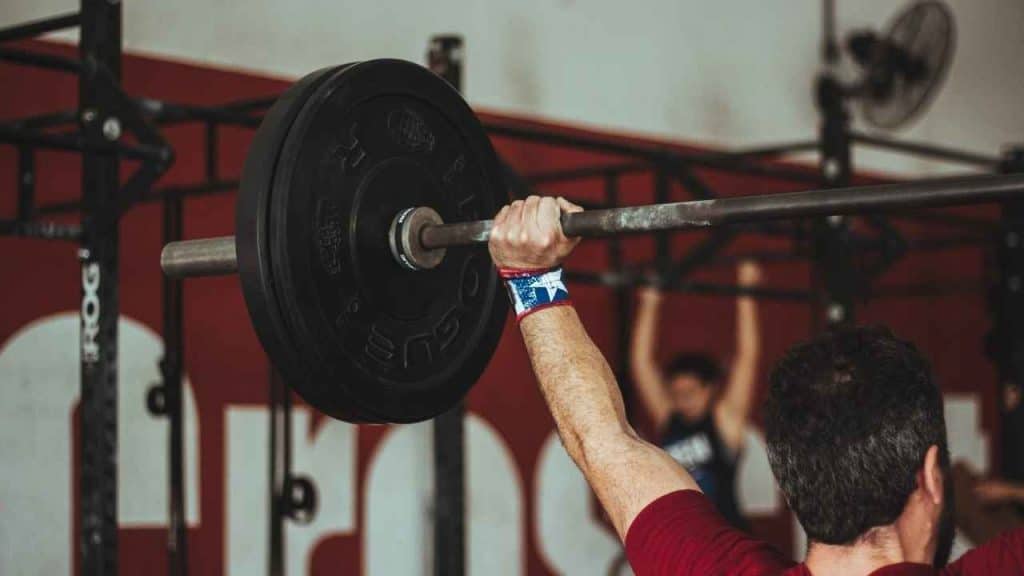Every martial artist’s dream is to earn a black belt in their discipline since there is usually a belt ranking system in most martial arts.
Typically, the highest rank you can receive is a black belt, though, in BJJ, this isn’t the case. The highest belt you can receive is actually a BJJ red belt, but since not many people are able to achieve such a rank, most people are unaware that you can go beyond black belt.
Do you have what it takes to earn a BJJ red belt? Here’s how you might earn one.
What are the BJJ Belts?
Although different BJJ gyms and affiliations will have individual belt guidelines, the most widely adapted belt guide is the IBJJF belt system.
Below is a diagram that shows the minimum age and time served to achieve each belt level.
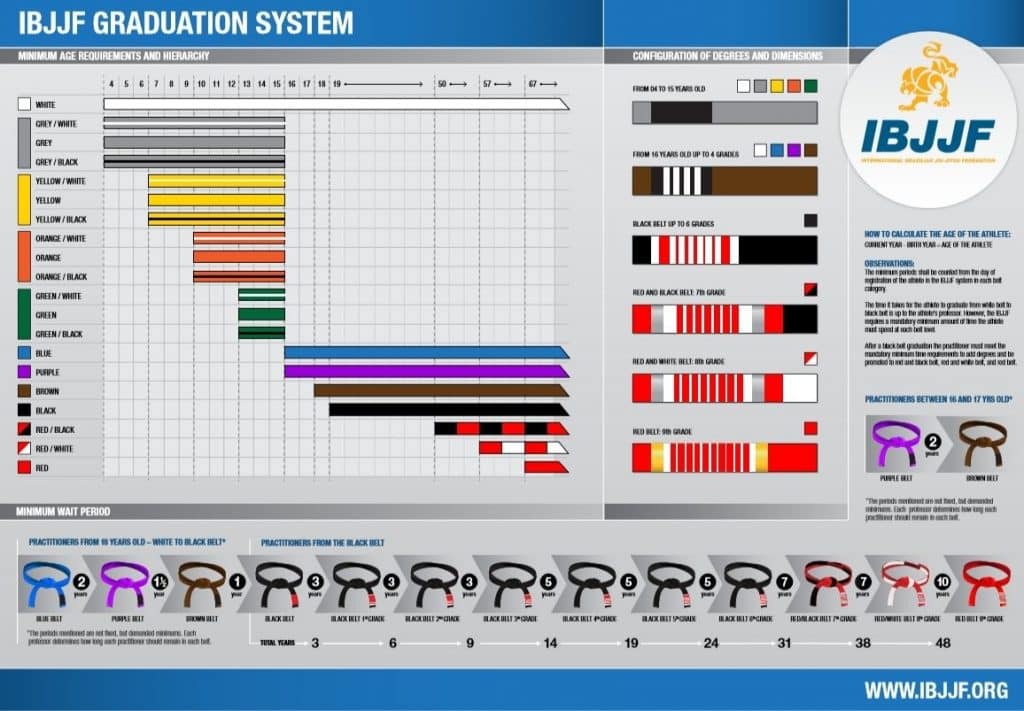
BJJ White Belt & BJJ Blue Belt
When you begin training BJJ, you’ll start as a white belt. On average, it will take you 1-2
years to level up to the next rank: blue belt; though if you train more than average, you can rank up in about 10-14 months. At white belt, you are learning the fundamentals of BJJ, how to move your body, and how to defend.
Once you have these basic understandings, you will rank up to blue belt. On average, a person stays at the blue belt rank for about five years.
Blue belts are those who show their understanding of the fundamentals but are still perfecting them.
BJJ Purple Belt
After blue belt comes purple belt. Purple belts are typically considered the most savage belts of them all. Mostly because at purple belt, you have a more advanced understanding of the fundamentals, and you have a good amount of attacks in your arsenal.
By purple belt, you have learned to pass the guard, maintain a dominant position, and successfully carry out a few submissions.
It is also important to note that you cannot earn a blue belt by BJJ rules until you are at least sixteen years of age and purple belts by at least eighteen years of age.
BJJ Brown Belt
The next rank is a brown belt, which will take you about 2-4 years to earn after receiving your purple belt.
At brown belt, you have a pretty well-rounded offence and defence game from each position. At this rank, you are mostly preparing for black belt and filling in any holes within your game.
It will take you about 1-3 years to earn your black belt after earning your brown belt.
BJJ Black Belt
Black belts take on average a decade to earn, along with dedication and passion to the art. At black belt, you have an understanding of BJJ as a whole. You also understand that BJJ is an ever-evolving art, and there is always something new to learn.
This is where most practitioners end their journey, but very few have ranked beyond black belt.
What is the Coral Belt?
Unknown to many, there is actually a belt between black and BJJ red belt. The coral belt is technically considered a 7th-degree black belt, also known as the ‘red and black belt.’
The only people who reach this ranking are true masters of BJJ and have significantly impacted the art.
Beyond the red and black belt is the red and white belt, also considered a coral belt, but is an 8th-degree black belt. IBJJF requires the coral belt recipients to stay at this ranking for at least seven years before being promoted.
One of the most recent people to receive a coral belt was Ricardo De La Riva in 2017. Some popular coral belts include Jean Jaques Machado, Carlos Gracie Jr., Royler Gracie, and Carlos Machado.
What is the Red Belt?
The BJJ red belt, otherwise known as the 9th-degree BJJ belt, is the highest BJJ rank that
you can achieve.
Once awarded a red belt, you are also considered a grandmaster of the art. Less than 50 people have ever earned a red belt, the earliest one awarded in the 1950s.
What’s interesting about this rank is that even if you earn your black belt at the age of 19, you would not earn your BJJ red belt until you are at least 67.
To earn a BJJ red belt, you must live and breathe BJJ. There is no other way than to envelop jiu-jitsu fully into your life.
What Is A 10th-Degree BJJ Red Belt?
The 10th-degree BJJ red belt has only been awarded to five people, those being BJJ
pioneers, also known as the first-generation Gracie brothers.
These five men are the ones who created BJJ, basing it off of the foundations of Japanese Ju-Jutsu. These men are the only men who will ever receive the 10th-degree BJJ red belt, and rightfully so.
The founding fathers Carlos, Oswaldo, George, Gaston, and Helio, devoted their blood, sweat, tears, spirit, and life to BJJ and are unmatched in the art.
Sadly, none of the five 10th-degree BJJ red belts are still alive.
10th Degree BJJ Red Belts
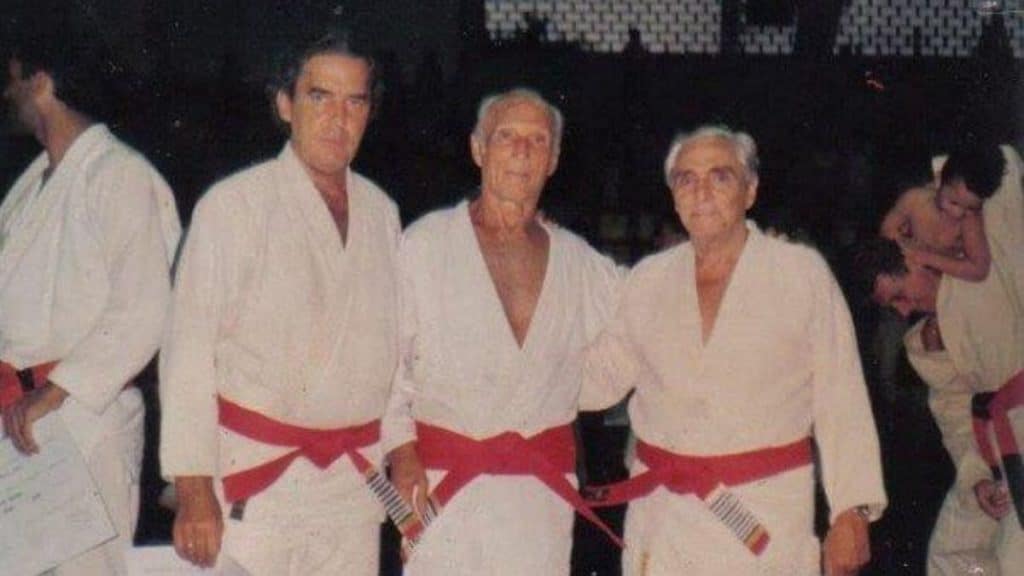
Hélio Gracie
Hélio Gracie is widely regarded as one of the most important figures in BJJ history. As-well as one of the first Gracie Jiu-Jitsu fighters to defend the art in the 1930s and 1940s, Hélio was also the father and instructor of many influential Gracie fighters of the 1990s.
Throughout his fighting career, Hélio openly challenged hundreds of martial artists in Brazil. Hélio fought fighters from multiple martial arts including; Wrestling, Judo and Boxing. His notable wins include Wladek Zbyszko, Yukio Kato and his former student Valdemar Santana.
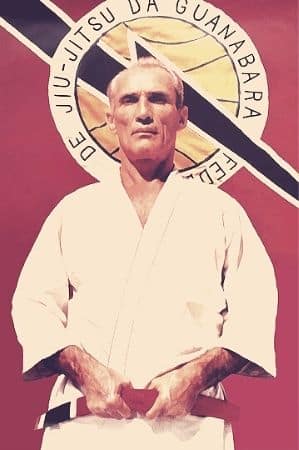
After his competition career, Helio dedicated himself to teaching the Gracie children. Helio taught many BJJ legends such as; Rickson, Relson, Carlos, Royce, and Carlson Gracie.
Hélio Gracie dedicated himself to the development of Gracie Jiu-Jitsu. Helio’s son, Rorion Gracie, was among the first Gracie family members to bring Gracie BJJ to the US. His other son Royce Gracie, went on to become the first UFC champion in the organization’s history. Hélio’s third oldest son Rickson, was considered to be the best fighter of the family in the 1980s and 1990s.
Grand Master Helio Gracie passed away in 2009.
Carlos Gracie
Carlos was one of the founding developers of Gracie Jiu-Jitsu and the oldest of the Gracie brothers.
Alongside his brother Helio and training partners Oswaldo Fadda and Luis França, he helped develop BJJ based on their experience of Kano Jiu-Jitsu under Mitsuyo Maeda.
Carlos Gracie was a martial arts visionary that founded the very first Gracie Jiu-Jitsu Academy in 1925. The academy was managed by Carlos Gracie with the help of his brothers, Helio, Oswaldo, Gastão and George.
Alongside running the Gracie Jiu-Jitsu Academy, Carlos also promoted fights between his academy and other traditional martial arts in Rio de Janeiro.
Carlos Gracie opened up other academies in Fortaleza and Ceará, Brazil. He was often away for business and left the running of his academy to his brothers. Carlos was regarded as the head of the family and cornered his brothers in almost every fight of their career.
Carlos died at the age of 92 in 1994. He had 21 of which 11 he awarded a black belt in Jiu-Jitsu to. Amongst his children are three BJJ legends; Rolls Gracie, Carlson Gracie and Carlos Gracie Jr.
Gastão Gracie
Gastão Gracie was the middle brother in the first generation of Gracie fighters.
Similar to Oswaldo Gracie, Gastão started learning Jiu-Jitsu via his older brother Carlos Gracie.
In 1925, Carlos Gracie opened up his first Gracie Jiu-Jitsu Academy. Gastao took an active role in the Gracie Jiu-Jitsu academy and helped take classes.
While Gastao was the least competitive of the Gracie brothers, he was deeply knowledgable in the art and formed great relationships with his students.
After various spells of teaching at the Gracie Jiu-Jitsu Academy, Gastão move to Sao Paulo where he settled for good. He remained teaching Gracie Jiu-Jitsu as more of a private instructor, working with people such as politicians, lawyers and wealthy businessmen.
Oswaldo Gracie
Oswaldo Gracie was one of the founding members of the first Gracie BJJ academy that opened in 1925.
Alongside his brothers, Oswaldo fought and defended the name of Gracie Jiu-Jitsu in Vale Tudo (no-holds-barred) events.
Oswaldo Gracie taught at the Gracie Jiu-Jitsu Academy until 1934.
After getting married he moved to the state of Minas Gerais. Oswaldo Gracie established the first Gracie Jiu-Jitsu academy in the state, and developed a gym of hot prospects, rivalling the gyms of Rio De Janeiro.
After he retired from competitive fighting, Oswaldo became a close combat instructor for the police force.
Jorge (George) Gracie
George Gracie was the second youngest Gracie brother, born in 2011.
After learning BJJ form his brother Carlos, George became the first Gracie Champion and represented the Gracie family all over Brazil fighting in different rulesets such as BJJ, Luta Livre, Vale Tudo and Wrestling.
During his competition days, George Gracie was one of the best fighters in Brazil and had one of the best unbeaten runs.
After Helio retired from competition in 1938, George Gracie was the last of the founding Gracie brothers to compete and represent the family.
Who has earned a BJJ Red Belt?
Those who have achieved the ranking of BJJ red belt are the best in the sport. They are
unmatched in their passion and dedication.
Here are all of the people, both alive and dead, who have ever earned a BJJ red belt (excluding the 10th-degree BJJ red belts):
- Pedro Hemeterio
- João Alberto Barreto
- Reyson Gracie
- Flavio Behring
- Carlson Gracie
- Carley Gracie
- Geny Rebello
- Armando Wridt
- Oswaldo Fadda
- Pedro Valente
- Luis Carlos Guedes de Castro
- Francisco Mansur
- Rorion Gracie
- Relson Gracie
- Francisco Sá
- Amelio Arruda
- Arthur Virgilio Neto
- Candido Casale “Candoca”
- Crézio Chavez
- Deoclécio Paulo
- Eduardo Gomez Pereira
- Geraldo Flores
- Helio Vigio
- José Higino
- Julio Secco
- Luiz Franca
- Nahum Rabay
- Nilton Pereira da Silva
- Octaivo de Almeida
- Oswaldo Carnivalle
- Oswaldo “Paqueta” Rosa
- Hilton Leão da Silva
- Paulo Mauricio Strauch
- Pedro Emerito
- Walter Nogueira
- Orlando Saraiva
- Rickson Gracie
- Carlos Antonio Rosada
Luiz França Filho
Luiz França Filho is a BJJ red belt and one of the primary founders of BJJ. He was the only founding member of BJJ who was not a Gracie brother.
França initially learned Kodokan Judo (also known as Kano Jiu-Jitsu) as a student of Soshihiro Satake, Geo Omori, and Mitsuyo Maeda.
During his time training in Belém, França trained under Mitsuyo Maeda at the same time as Carlos Gracie.
After years of training in São Paulo, Luiz França Filho moved to Rio De Janeiro and began teaching grappling to police officers, military personal, and poor people in the favelas.
Conclusion
Each rank in BJJ takes a level of commitment, dedication, and passion.
It takes an entire life’s worth of dedication and training to earn a BJJ red belt. As those who have earned one, you must live and breathe BJJ. It is not as easy as it looks, especially since it is challenging even to receive a first-degree black belt.
If BJJ is truly your passion, you may have what it takes to become a grandmaster of the art.
If you enjoyed our BJJ red belt guide, share it using the button below.

